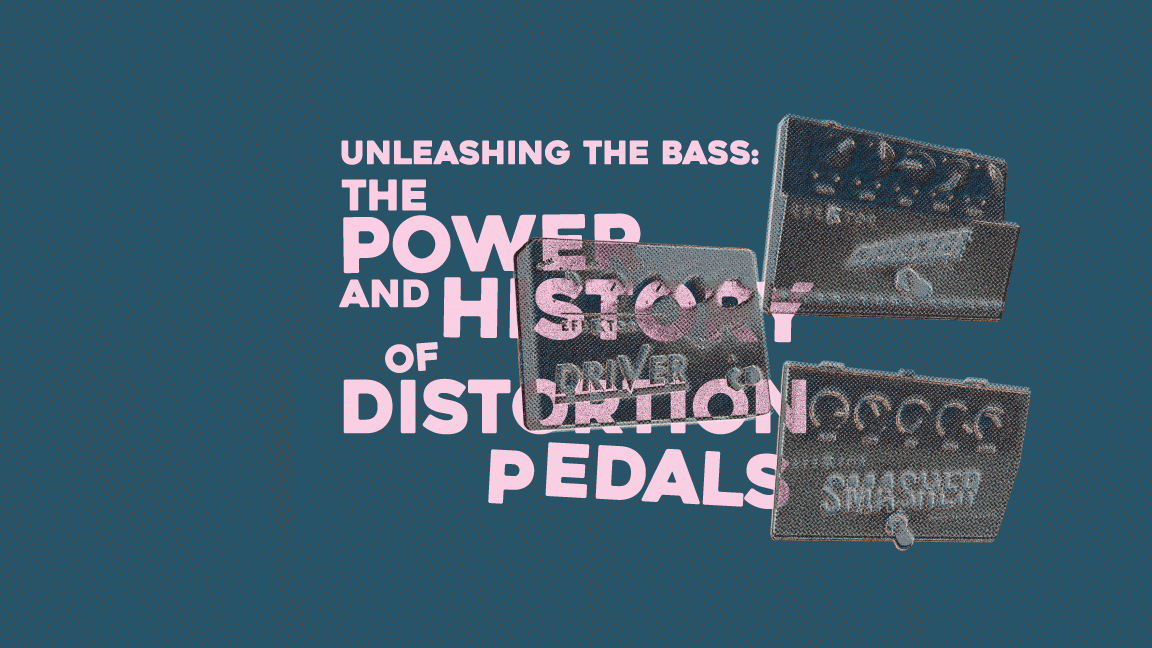
Bass effect pedals are critical for the tone that gives power, build a solid foundation for a track’s groove, and to a bigger extent; great sounding mixes and masters. In order to achieve this result without losing the original character of the bass, it is important to use a plugin with good analog modeling. This type of technology is critical in retaining the essential bass frequencies while also preserving the unique tone of the original instrument, allowing for a more nuanced and authentic sound.
The origin of bass distortion
The history of bass distortion can be traced back to the 1960s, when electric guitarists experimented with various effects pedals in a bid to create new sounds. Bass distortion was one of the first effects available along with the guitarists first fuzz pedals and distortion boxes. The heavy metal genre popularized bass distortion in the 1970s even further , when artists such as Iron Maiden and especially Black Sabbath used the distortion to produce a powerful and aggressive sound – riding along with the already heavy guitars in the arrangements. Bass distortion was used to create hard-hitting riffs , intros and whole bass solos heard in the early recordings of Metallica too. Here are some remarkable examples:
Cliff Burton’s bass solo (Anesthesia) Pulling Teeth.
https://www.youtube.com/watch?v=lRArbRr-61E
Also, make sure to check out the: NIB by Black sabbath.
Bass distortion became a staple in grunge, alternative rock, and punk in the 1980s and 1990s. Bands used it to create a raw, distorted sound that was different from the traditional bass guitar. Today, bass distortion remains a popular effect for use in rock, metal, and other genres of music. It is also found in genres like hip-hop, giving the bassline an aggressive edge. The distortion pedals could be used to spice up your synth bass lines.
What is a Bass Distortion pedal?
A bass distortion pedal is an effect pedal specifically designed for the bass guitar.It distorts the original signal by adding extra frequencies and harmonics to it. This produces a distorted, heavy sound that can be used to create a wide range of effects, from heavy metal riffs to a warm, fuzzy distortion. Bass distortion pedals come in a variety of the distorted signal types, such as: overdrives, tube preamps, distortion pedals and fuzz pedals, giving you more options to get the desired bass tone. Besides that, some pedals include additional capabilities such as tone shaping filters, capacitor choices, different clipping options and so on.You can make any unique bass guitar tones with these features, making the bass distortion pedal an essential part of your rig.
Fortunately, we live in a digital age where you can load your favorite pedal as a VST plugin in front of an amp simulator plugin and start recording in the blink of an eye.
A list of some popular bass distortion pedals
Here are the top five bass distortion pedals on the market, along with descriptions and links to the famous Reverb store:
-
-
- Darkglass Electronics Microtubes B7K Ultra – This pedal provides a variety of distortion tones, ranging from subtle overdrive to heavy fuzz. It has a 4-band EQ as well as a built-in DI for direct recording or live sound. For metal and rock bassists, the B7K Ultra is a popular choice.
https://reverb.com/p/darkglass-electronics-microtubes-b7k-ultra-bass-preamp-pedal - MXR M80 Bass D.I. For recording or live sound, this pedal combines distortion with a DI output. It has a 3-band EQ as well as a “dry” knob for blending in your clean signal. The M80 is an excellent option for any bassist.
https://reverb.com/p/mxr-m80-bass-di-plus-distortion-pedal - Electro-Harmonix Bass Big Muff Pi – A classic fuzz/distortion pedal that has been popular with bassists for decades. It has a tone control as well as a “dry” knob to blend in your clean signal. The Bass Big Muff Pi is ideal for creating vintage and modern rock sounds.
https://reverb.com/p/electro-harmonix-bass-big-muff-pi-distortion-sustainer - Aguilar Agro Bass Overdrive – With a diverse variety of distortion tones and a 3-band EQ for tone shaping, this pedal is specifically designed for bass. The Agro is a popular bass for funk, rock, and metal players.
https://reverb.com/p/aguilar-agro-bass-overdrive-pedal - Aftershock Bass Distortion by Source Audio – This pedal offers an extensive selection of distortion tones, from classic overdrive to modern high-gain tones. It comes with a 3-band EQ, a clean control for combining in your dry signal, and six different distortion engines to help you customize your sound. The Aftershock is a versatile and effective tool for any bassist looking to enhance their sound
- Darkglass Electronics Microtubes B7K Ultra – This pedal provides a variety of distortion tones, ranging from subtle overdrive to heavy fuzz. It has a 4-band EQ as well as a built-in DI for direct recording or live sound. For metal and rock bassists, the B7K Ultra is a popular choice.
https://reverb.com/p/source-audio-aftershock-bass-distortion
-
Our new Efektor Pedals lineup created for the bass!
Efektor Bass Cruncher Preamp, Bass Smasher Distortion, and Bass Driver Preamp plugins.
If you’re looking for a bass pedal to help with sound production but aren’t sure which styles to choose, consider our Efektor Bass Distortion pedal lineup audio plugins. You will be able to move from warm studio bass tones, to focused slap bass sounds and roaring, full with harmonic distortion bass tones that will fit in any production on demand.
We included 3 of the most versatile pedals ever. From a vintage or clean studio bass pre, through a nice and gritty overdrive, to crazy distortion that goes into the fuzz territory when pushed hard. Using software bass guitar VST, or au plugins is the new reality. Embrace it!
Final words:
A good bass pedal is one that assists in the creation of the proper sound for your instrument. Don’t be afraid to plug your bass into a dedicated bass pre or distortion pedal and spice up your tone. It might just come to your aid!
Happy rumbling!


